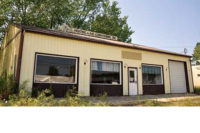One successful Wisconsin mechanical contractor sees a lot of reasons why ammonia is a smart choice. Bassett Mechanical, with locations in Kaukauna, Madison, and Milwaukee, specializes in several markets, including industrial refrigeration; HVAC; industrial ventilation; metal fabrication; and plumbing, piping, and electrical services.
Dave Schaefer, engineering manager of construction services for Bassett, said that in some applications, ammonia is the only refrigerant of choice. “For the larger refrigeration systems ammonia or ammonia-CO2 solutions are the only commercially viable options, since the phaseout of R-22,” he said.
Before talking about its advantages, let’s take a quick refresher course on ammonia. Ammonia is a gas made up of two other gases: nitrogen and hydrogen. It is colorless and has a strong, pungent odor. Ammonia is frequently used commercially in large freezing and refrigeration plants. It is also called “anhydrous ammonia” because it contains almost no water (99.98 percent pure).
Schaefer listed several advantages to using ammonia over other refrigerants. “First is the cost,” he said. “Ammonia refrigerant is 75 cents per pound versus others such as Freon, which is about $15 per pound.
“Ammonia is one of the most energy-efficient refrigerants, too.” Ammonia is 3-10 percent more efficient than CFCs, so an ammonia-based system requires less electricity, resulting in lower operating costs.
Schaefer said ammonia is readily available and added some more advantages. “It is self-alarming,” he said. “If there is a leak, the odor makes its readily apparent. Ammonia can be used in a flooded evaporator coil, meaning you can get more cooling capacity out of a smaller coil.
“Lastly, ammonia is an all-natural refrigerant, making it environmentally friendly. It has no impact greenhouse gases and doesn’t contribute to global warming. You can also tell your customers they can get LEED points for using an ammonia refrigeration system.”
Ammonia has an ozone depletion potential (ODP) rating of 0 and a global warming potential (GWP) rating of 0.
While ammonia is a popular choice, it does have a couple of disadvantages, too. It is not compatible with copper, so it can’t be used in any system with copper pipes. It is also toxic in high concentrations. Fortunately, ammonia’s sharp odor is detectable at concentrations well below those considered to be dangerous. It is also lighter than air, so if any does leak, it will rise and dissipate in the atmosphere.
Schaefer said his company would like to use ammonia in a cascade refrigeration system, where the refrigeration operates in a series of two or more cycles and may contain different refrigerants including CO2. But he said, “We haven’t had a customer who is seeking this type of application. We are, however, prepared to develop such a system because we believe that it is a good solution. CO2 is a good, carbon-neutral, refrigerant that along with ammonia makes a promising solution.”
Publication date: 10/31/2011











